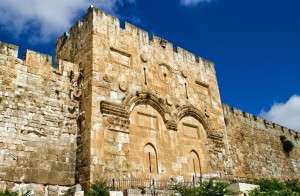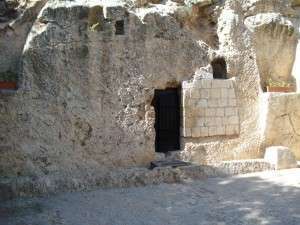
2014 06 01 The Golden Gate, also known as: Gate of Mercy, Gate of Eternal Life, Beautiful Gate.
Modern day Jerusalem has two famous entrances. One stands wide open today, and the other has been sealed shut for the last 500 years. One entrance was sealed long ago, intending to keep Jesus in; another entrance is still sealed today, intending to keep Jesus out.
Let’s look at the entrance that is still sealed today first.
This entrance is called the Eastern Gate. It is the only gate on the eastern side of the wall that surrounds the city of Jerusalem. That gate faces the Mount of Olives, with the Kidron Valley (or the Valley of Jehoshaphat which means “The valley where Yahweh shall judge”) in between.
Not long before Jesus was arrested and then crucified, He came down from the Mount of Olives riding on a donkey, crossed the Kidron Valley and entered Jerusalem through the Eastern Gate. The crowds saw Jesus as their conquering king so “… when they heard that Jesus was coming to Jerusalem, took the branches of the palm trees and went out to meet Him, and began to shout, ‘Hosanna!
The Romans destroyed the Eastern Gate in 70 A.D. when they leveled Jerusalem and the Jewish Temple. Sometime in the sixth or seventh century, the Byzantines rebuilt the wall around Jerusalem, including the Eastern Gate. When the Muslim Turks conquered Jerusalem in 1541, Suleiman the Magnificent had the Eastern Gate sealed shut. Tradition tells us that he closed the Eastern Gate so that the Jewish Messiah would not be able to enter a second time as predicted in Ezekiel 44:1-3. Suleiman also put a Muslim cemetery in front of the gate thinking that no Jewish leader would defile himself by going through it.
We know that neither the cement sealing the gate nor the cemetery in front of it will stop Jesus from entering Jerusalem when He returns as He promised. We know this for sure because of the other famous entrance in Jerusalem. Although that one was sealed to keep Jesus inside, it has been wide open now for over 2,000 years.
 When Jesus died, His body was placed in a tomb carved out of rock. The entrance to His tomb was covered by a large, round stone that was probably in a groove to guide it so that it could be rolled over the opening. That entrance was sealed tight to keep Jesus’s body inside. Matthew, Mark and Luke all tell us that this stone was “rolled back,” but John adds two fascinating words to describe what happened. The first Greek word is translated, “taken away.” It means to lift, carry, or bear. The second word is translated “from.” So we know that the stone was lifted up out of its track and carried it away from the tomb. The door, so to speak, had been “torn off its hinges.” What power! As one man put it, “The heavy, ponderous stone that sealed Jesus in the confines of that rock-walled tomb was but a pebble compared to the Rock of Ages inside.”
When Jesus died, His body was placed in a tomb carved out of rock. The entrance to His tomb was covered by a large, round stone that was probably in a groove to guide it so that it could be rolled over the opening. That entrance was sealed tight to keep Jesus’s body inside. Matthew, Mark and Luke all tell us that this stone was “rolled back,” but John adds two fascinating words to describe what happened. The first Greek word is translated, “taken away.” It means to lift, carry, or bear. The second word is translated “from.” So we know that the stone was lifted up out of its track and carried it away from the tomb. The door, so to speak, had been “torn off its hinges.” What power! As one man put it, “The heavy, ponderous stone that sealed Jesus in the confines of that rock-walled tomb was but a pebble compared to the Rock of Ages inside.”
The greatest proof of the power of Jesus Christ is that He raised Himself to new life after being dead for three days. Not only that, but Jesus predicted ahead of time what would happen (see Matthew 16:22).
The resurrection of Jesus from the dead assures us that He is alive today, and that He is coming back someday (perhaps soon!) to claim His rightful place as King of His own creation.
One day, Jesus will return and open the Eastern Gate as effortlessly as He opened the garden tomb. “Lift up your heads, O gates, and be lifted up, O ancient doors, that the King of glory may come in! Who is the King of glory? The Lord strong and mighty, the Lord mighty in battle. Lift up your heads, O gates, and lift them up, O ancient doors, that the King of glory may come in! Who is this King of glory? The Lord of hosts, He is the King of glory” (Psalm 24:7–10).
When Jesus returns will He find you as one of His followers? The “surpassing greatness of [Christ’s]power[is] toward us who believe. These are in accordance with the working of the strength of His might which He brought about in Christ, when He raised Him from the dead and seated Him at His right hand in the heavenly places, far above all rule and authority and power and dominion, and every name that is named, not only in this age but also in the one to come” (Ephesians 1:19–21).

AMEN!